#fezouata
Explore tagged Tumblr posts
Text
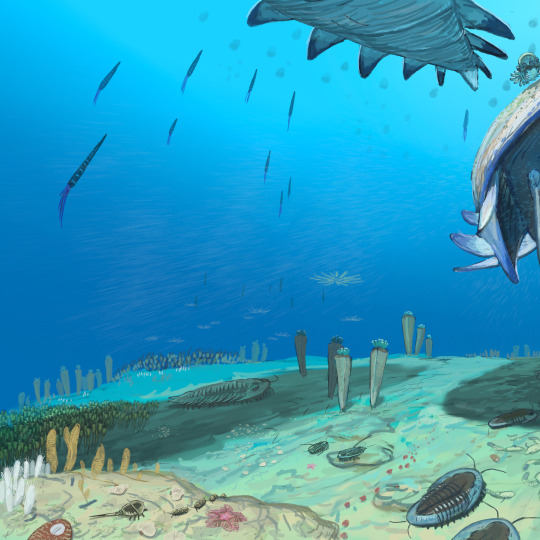

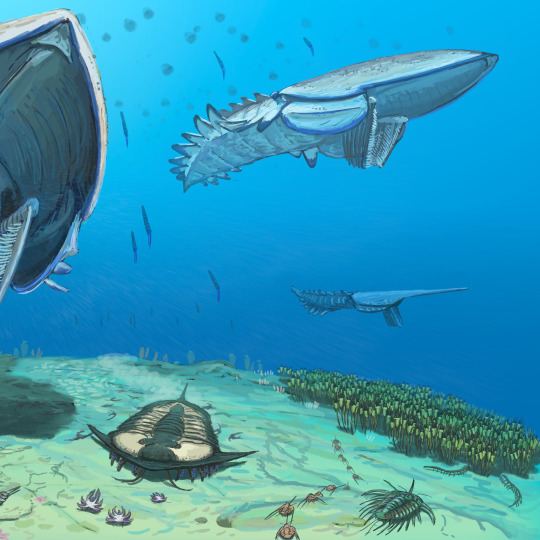
Detail shots. The middle one was basically the whole driver for this piece, everything was planned around the Aegirocassis swooping in.
The majesty and sheer size of these creatures still baffles me, large specimens could be a little over 2 meter long, they dwarfed everything in their world.
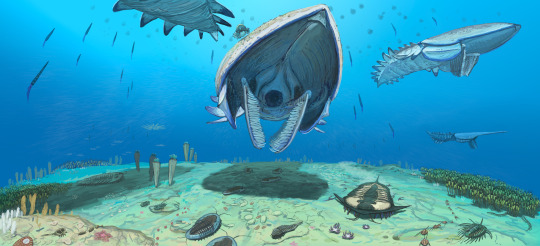

Result from the Fezouata formation #paleostream!
Behold the emperor of the Ordovician visits its benthic subjects!
#paleoart#sciart#paleostream#palaeoblr#ordovician#aegirocassis#trilobite#underwater#radiodont#morocco#fezouata
394 notes
·
View notes
Photo
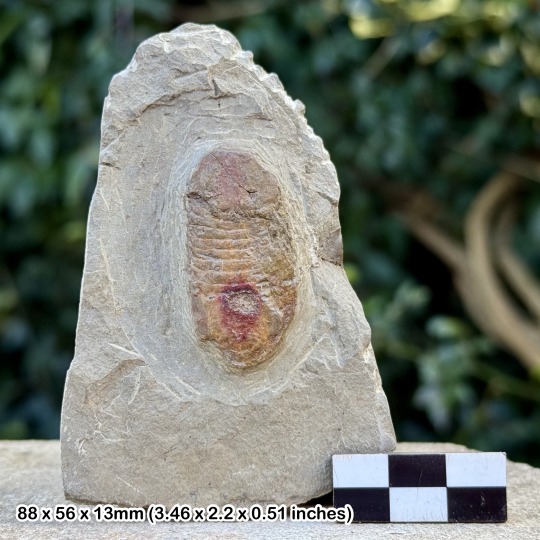
Asaphid Trilobite Fossil - Fezouata Formation, Ordovician Morocco - Genuine Specimen w/ COA
Own a stunning Asaphid Trilobite Fossil from the renowned Fezouata Formation, Morocco, a beautifully preserved specimen from the Ordovician period, dating back over 470 million years. This fossil represents one of the earliest and most successful marine arthropods, offering a fascinating glimpse into prehistoric marine ecosystems.
Trilobites were an extinct group of arthropods that thrived in ancient oceans for nearly 270 million years. The Asaphid trilobites were a widespread and successful family, known for their smooth, streamlined exoskeletons and distinct segmented bodies. The Fezouata Formation is one of the world’s most significant fossil sites, producing exceptionally preserved fossils that help scientists understand life in the Ordovician seas.
Each fossil is 100% genuine and comes with a Certificate of Authenticity, guaranteeing its authenticity and scientific significance. The exact specimen shown in the listing photos is the one you will receive, ensuring complete transparency. A 1cm scale cube/rule squares is included in the image for reference—please check the listing photos for full sizing details.
Why Choose This Fossil? ✔️ Authentic Asaphid Trilobite Fossil from Fezouata Formation, Morocco
✔️ Exceptional Preservation with Fine Details
✔️ Comes with a Certificate of Authenticity
✔️ Perfect for Collectors, Museums & Educational Display
✔️ Fast & Secure Shipping
Own a piece of ancient history with this Asaphid Trilobite Fossil—order today!
#Trilobite Fossil#Asaphid Trilobite#Fezouata Formation#Ordovician Fossil#Morocco Trilobite#Rare Fossil#Prehistoric Arthropod#Paleozoic Fossil#Fossil Collector#Natural History#Ancient Sea Life#Fossilized Trilobite#Trilobite Display#Geological Specimen#Authentic Fossil#Certificate of Authenticity#Museum-Quality Fossil
0 notes
Text

Paleo-Files: Aegirocassis
Aegirocassis benmoulai is a species of giant, 2.3-meter-long filter-feeding arthropod that lived about 480-472 million years ago in the depths of the early Ordovician seas of what is now the Fezouata Formation of Morocco. Ever since its discovery in 2015, Aegirocassis is considered to be the first giant, aquatic, filter-feeding animal that evolved in Earth’s history, preceding the evolution millions upon millions of years later of future large, marine filter-feeders such as the Jurassic ray-finned fish Leedsicthys, the Cretaceous plesiosaur Aristonectes and the baleen whales and whale sharks of the Cenozoic. It was also the largest member of the Hurdiidae, a diverse family of marine radiodont arthropods of the Cambrian and Ordovician periods that includes the famous carnivorous Anomalocaris, and it might have evolved its filter-feeding traits, such as endites or inner structures of its frontal appendages that bore large amounts of baleen-like auxiliary spines that could have been used as a sort of mesh, from smaller, carnivorous ancestors as a result of the Great Ordovician Biodiversification Event, in which certain environmental changes at the time witnessed the diversification of plankton, and in turn the flourishing of new suspension-feeding organisms. The spines of this strange arthropod’s frontal appendages were inward-angled, which allowed them to overlap to a certain degree and thus allow for more control over the size of the filtering mesh, and this unique feature may halve allowed Aegirocassis to feed on bigger-sized zooplankton than other filter-feeding radiodonts, along with large carapace that could have also helped to guide the feeding current to the frontal appendages. Aegirocassis shared its deep-sea habitat with the closely-related radiodont Pseudoangustidontus and several other, smaller arthropods, microorganisms and trilobites, and was also the single largest member of the highly-diverse Fezouata biota.
#paleoart#paleontology#aegirocassis#arthropod#arthropods#ordovician#paleozoic#paleozoic era#paleontology art#paleoartwork#palaeoart#palaeontology#paleography#paleoblr#palaeoblr#prehistoric animals#palaeontology art#artists on tumblr#paleoartists on tumblr
40 notes
·
View notes
Text
Trilobite of the Day 45

Asaphellus stubbsi (Fortey, 2009) Lower Ordovician, Tremadocian Fezouata Formation Anti-Atlas mountains, Morocco 16 cm
"It maybe stubby but look at them fancy flanges"
#posting#trans paleontologist#trilobites#paleontology#trilobite of the day#trilobite#invertebrate paleontology#fossils
56 notes
·
View notes
Photo
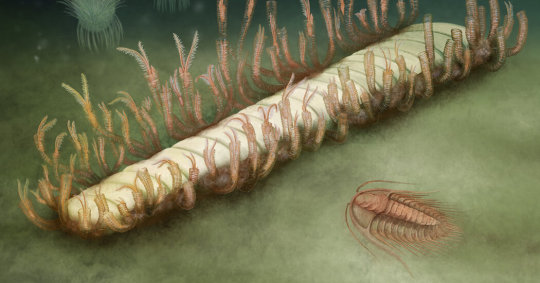
Fossil Reveals Ancient Seafloor Communities
Remnants of decaying tiny animals were colonized by others in an interspecies interaction dating back 480 million years.
https://www.nytimes.com/2023/10/11/science/fossil-fezouata-interspecies.html
#eartharchives#paleomedia#paleontology#fossil#fossils#evolution#evolutionarybiology#naturalhistory#magazine
16 notes
·
View notes
Text
NYTimes: Fossil Reveals Ancient Seafloor Communities
Fossil Reveals Ancient Seafloor Communities https://www.nytimes.com/2023/10/11/science/fossil-fezouata-interspecies.html?smid=nytcore-android-share
0 notes
Photo
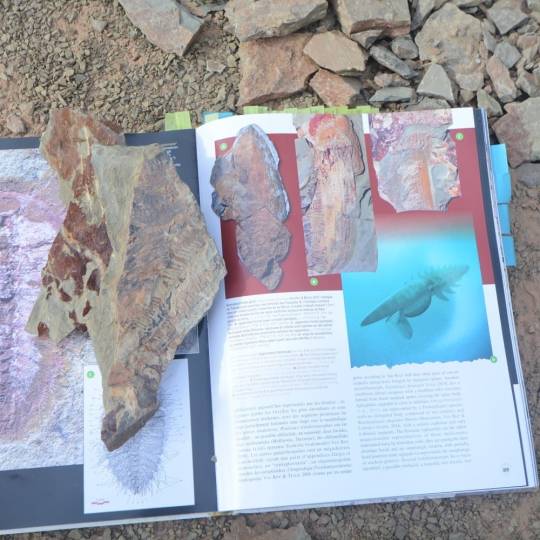
Today we had a really fantastic day in #Morocco with soft bodied #anomalocarididae (pics 1 & 2) from the lower #Ordovician #fezouata Shale #lagerstätte , giant #trilobites also from the Fezouata Shale (pic 3) and #edicarian #stromatolites (pics 8 &10) The first stop near Ouarzarzate was the 570 million year old stromatolites that grew in the Edicarian, the last period of the #precambrian The stromatolites grew around the shore of ponds in a volcanicly active area. Pic 9 shows ripples in a tuff layer (volcanic ash), this tuff layer buried older stromatolites, and the pond water formed the ripples. Later stromatolites then formed above the tuff layer. Pic 10 shows the amazing landscape that the stromatolites form and this surface has perhaps remained unaltered for the last 570 million years! We then drove on through precambrian limestone (pic 7) to reach Cambrian and Ordovician strata near Agdiz. Our first stop in the lower Ordovician Fezouata Shale was to see the discovery site of the giant Dikelokephalinid trilobites (pic 5). Here we saw the diggings where fossil miners had extracted specimens and we examined their discarded fragments. Pic 4 shows an articulated head and thorax of a Dikelokephalinid. Tom also found a #graptolite (pic 6). Our final stop was the Lagerstatte section of the Fezouata Shale, here exceptional preservation reveals soft bodied "Burgess Shale" type fauna such as Anomalocaridids and marrellomorphs. The Lagerstatte was discovered by Mohamed Oussaid Ben Moula (known as Ben Said) during the winter of 1999-2000, and featured on the front cover of Nature in 2010. We were lucky enough to meet Ben Said (pic 3) and his son (pic 2) where he is showing an anomalocaridid to our driver Yousef. https://www.instagram.com/p/B40gGVGpwhN/?igshid=2dd80q35wtiv
#morocco#anomalocarididae#ordovician#fezouata#lagerstätte#trilobites#edicarian#stromatolites#precambrian#graptolite
0 notes
Photo
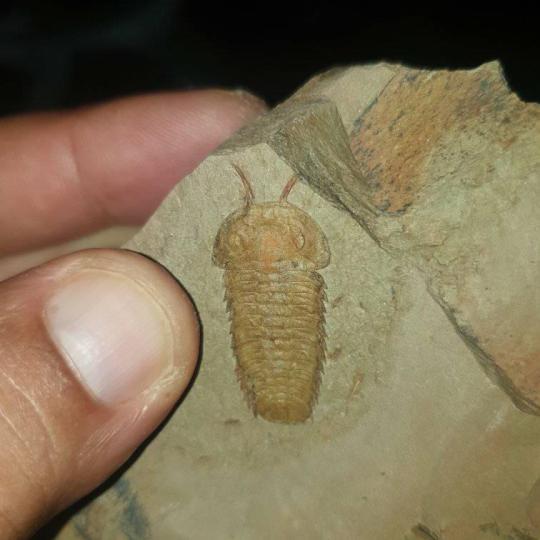
Fezouata trilobite showing rare soft-body preservation. Look at the preserved antennae!
62 notes
·
View notes
Photo
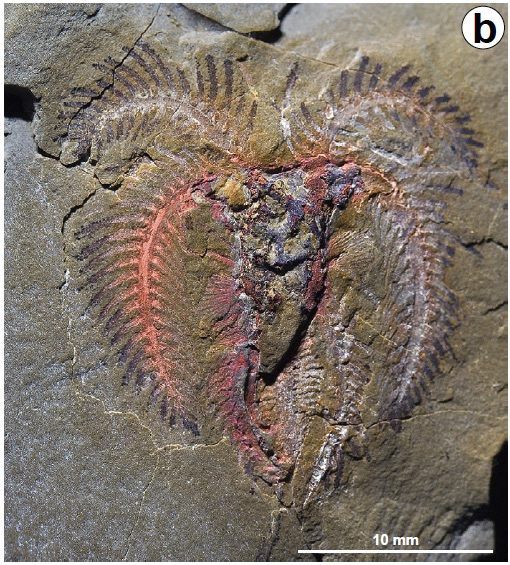
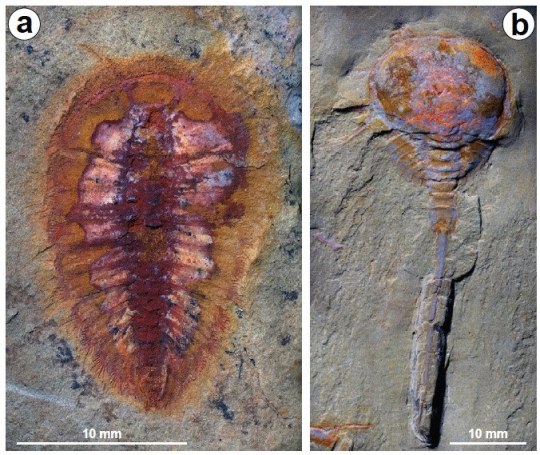
For #fossilfriday, meet the Fezouata Biota In 2010, a paper on the Fezouata formation in the Anti-Atlas Mountains of southeastern Morocco described the unit as a possible Lagerstätte – a location of exceptional fossil preservation including remnants of the soft parts of organisms. These are some of the discoveries in that unit.
The Fezouata formation fossils are Ordovician in age, making them just slightly younger than what is likely the world’s most famous example of Lagerstätte; Canada’s Burgess Shale. Therefore, they have already been extremely useful in reconstructing the geologic evolution of a number of species and how Cambrian and Ordovician life connect. The first image shows an animal organism known as Aegirocassis benmoulai. It is one of the oldest discovered filter-feeding organisms in the ocean; there are a few examples of older specimens but they are not nearly as well preserved as this creature. The Ordovician was a time of diversification of ocean-living planktonic organisms; finding this fossil allows scientists to see how predation of planktonic life (a technique still used today by organisms even as large as whales) originally formed in the ocean. The other 2 images show species that have had their fossil origin pushed farther back in time. The left image is a cheloniellid arthropod – an extinct branch of arthropods that is related to trilobites and arachnids but was somewhere in-between and occupies a poorly understood place in the evolutionary tree. Finding this fossil may help better understand its origin and place in the tree. Finally, the last image is a fossil horseshoe crab. This fossil is 25 million years older than any previously discovered horseshoe crab, and finding it commonly within this formation allows scientists to better understand how its fused body parts evolved. The colors are gorgeous, but unfortunately they’re not directly representative of the organisms. These fossils were preserved through a combination of quiet water and chemistry. The organism bodies were locked into mineralized shells after they died from a combination of their own chemistry, interactions with bacteria that consumed the bodies after death, and minerals in the water – most likely supplied from volcanic ashes entering whatever lake system held the organisms. This process also produced pyrite, which stains the fossils red and pink as it weathers. -JBB Image credits: http://dx.doi.org/10.1144/jgs2015-017 (Open access paper) Read more: http://t.co/iP9iw1JSf7
#Lagerstätte#fossil#fossils#fossilfriday#horseshoe crab#geology#paleontology#science#rock#liemstone#ordovician#arthropod#the earth story
147 notes
·
View notes
Photo


This is a cluster of three rare, fossil aglaspids (Tremaglaspis) from the Upper Fezouata Formation of Morocco. Aglaspids are a rare type of arthropod which was probably related to trilobites. For a while was regarded as the ancestors to horseshoe crabs, though this theory has fallen out of favor.
From: https://www.fossilera.com/fossils/multiple-soft-bodied-fossil-aglaspids-tremaglaspis-morocco
56 notes
·
View notes
Text
Descubren 'mundo marino enano' de hace 462 millones de años en Castle Bank, Gales
Castle Bank ofrece una nueva perspectiva sobre la evolución animal temprana, revelando el próximo capítulo en el desarrollo del ecosistema después de las biotas de Chengjiang, Burgess Shale y Fezouata vía @nature.
Agencias/Ciudad de México.- Un “mundo marino enano” inusualmente bien conservado de hace 462 millones de años ha sido descubierto en Castle Bank, Gales. El sitio comprende más de 150 especies, muchas de ellas de tamaño corporal miniaturizado. Es uno de los yacimientos de fósiles más inesperados del mundo. El estudio, dirigido por el Instituto de Geología y Paleontología de Nanjing de la Academia…

View On WordPress
0 notes
Text
We are approaching the maximum of images you can post here so I thought it was time I make a little showcase of all the formation pieces we covered so far on the streams.

Chaneres Formation

Hanson Formation

Guimarota Formation

Winton formation

Holocene Madagascar

Riversleigh

Kimmeridge Clay

Tapinocephalus Assemblage Zone

Hunsrück Slate

Yixian Formation

Paja Formation

Besano Formation

Pebas megawetland

Fezouata Formation

Ngorora Formation

Kuldana Formation

Madygen Formation

Jebel Qatrani '

Holocene Cuba

Pierre Shale

Crato Formation

Archer City Formation

Tambach Formation

La Brea tar pits

Morrison Formation

Sannine Formation

Ballagan Formation

Shanwang Formation

Austrian Paratethys
For people who don't know: for several months now I draw one formation or fossil locality every Saturday. The next place we visit is chosen by a wheel of names, which we also constantly fill up again when a new formation is picked.
I try to make it as interesting as possible in my composition and choice of animals and I can tell you this series has been a great training when it comes to constructing these, how I call them, Menageries.
I have to thank a team of friends and colleagues who help behind the scenes with research, creation of size charts and conversation partners when it comes to deciding on the compositions of these pieces. Their help has been invaluable!
#paleoart#sciart#paleostream#palaeoblr#cretaceous#dinosaur#jurassic#pterosaur#sauropod#formations#miocene#eocene#triassic#devonian#carboniferous#labrea#morrison#bromacker#permian#deeptime#scicomm
13K notes
·
View notes
Photo
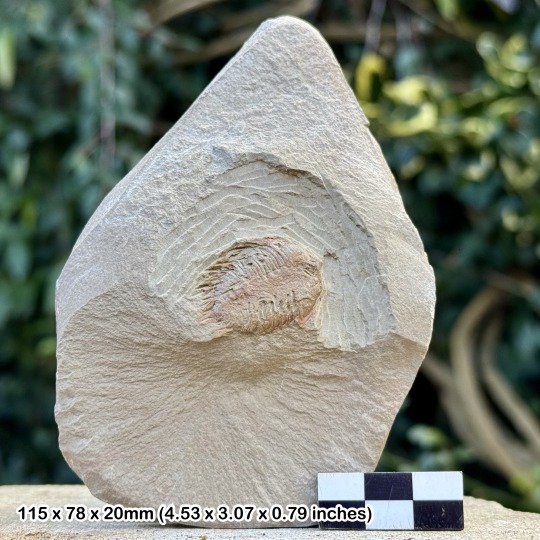
Asaphid Trilobite Fossil - Fezouata Formation, Ordovician Morocco - Genuine Specimen w/ COA
Own a stunning Asaphid Trilobite Fossil from the renowned Fezouata Formation, Morocco, a beautifully preserved specimen from the Ordovician period, dating back over 470 million years. This fossil represents one of the earliest and most successful marine arthropods, offering a fascinating glimpse into prehistoric marine ecosystems.
Trilobites were an extinct group of arthropods that thrived in ancient oceans for nearly 270 million years. The Asaphid trilobites were a widespread and successful family, known for their smooth, streamlined exoskeletons and distinct segmented bodies. The Fezouata Formation is one of the world’s most significant fossil sites, producing exceptionally preserved fossils that help scientists understand life in the Ordovician seas.
Each fossil is 100% genuine and comes with a Certificate of Authenticity, guaranteeing its authenticity and scientific significance. The exact specimen shown in the listing photos is the one you will receive, ensuring complete transparency. A 1cm scale cube/rule squares is included in the image for reference—please check the listing photos for full sizing details.
Why Choose This Fossil? ✔️ Authentic Asaphid Trilobite Fossil from Fezouata Formation, Morocco
✔️ Exceptional Preservation with Fine Details
✔️ Comes with a Certificate of Authenticity
✔️ Perfect for Collectors, Museums & Educational Display
✔️ Fast & Secure Shipping
Own a piece of ancient history with this Asaphid Trilobite Fossil—order today!
#Trilobite Fossil#Asaphid Trilobite#Fezouata Formation#Ordovician Fossil#Morocco Trilobite#Rare Fossil#Prehistoric Arthropod#Paleozoic Fossil#Fossil Collector#Natural History#Ancient Sea Life#Fossilized Trilobite#Trilobite Display#Geological Specimen#Authentic Fossil#Certificate of Authenticity#Museum-Quality Fossil
0 notes
Text
Des arthropodes géants de 2 mètres de long dominaient les mers il y a 470 millions d'années
See on Scoop.it - EntomoNews
Giant relatives of modern insects and crustaceans are not just the stuff of horror movies, having dominated the seas of what is now Morocco during the Early Ordovician Era.
Giant 2-Meter-Long Arthropods Dominated The Seas 470 Million Years Ago
Stephen Luntz, 13.12.2022
New fossil assemblages from the Early Ordovician Fezouata Biota | Scientific Reports, 13.12.2022 https://www.nature.com/articles/s41598-022-25000-z
[Image] Arthropods are now numerous, but in the early Ordovician they were also large, and some particularly enormous examples have now been found at Taichoute, Morocco, such as this non-mineralized arthropod (marrellomorpha) and palaeoscolecid worm. Image Credit: Emmanuel Martin.
0 notes
Text
Trilobite of the Day 42

Apatokephalus cf. incisus (Dean, 1966) Lower Ordovician, Floian stage Upper Fezouata Formation (Outer Feijas Group) Zagora, South Morocco 5 cm
*extremely yinzer voice* "Hey Apato, yinz Kennywood's Open!"
#yinzer#pittsburghese#pittsburgh#trilobite of the day#trans paleontologist#trilobites#posting#paleontology#trilobite#invertebrate paleontology#fossils#Kennywood
20 notes
·
View notes
Photo

Newly discovered fossils give a whole new meaning to jumbo shrimp
The Moroccan desert was once a sea filled with unique, gigantic, free-swimming arthropods 470 million years ago.
sulc.us/fezouata
#eartharchives#paleomedia#paleontology#fossil#fossils#evolution#evolutionarybiology#naturalhistory#magazine
67 notes
·
View notes